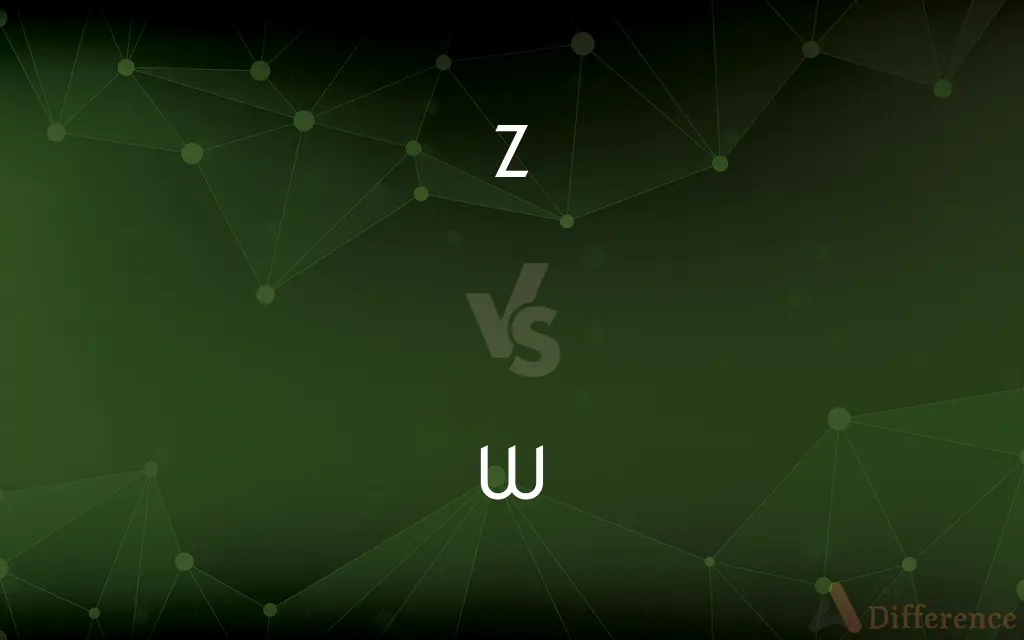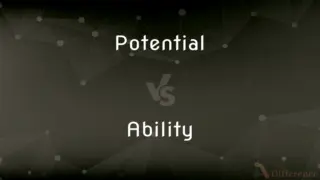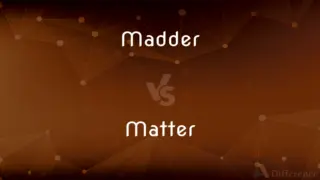Z vs. W — What's the Difference?
Edited by Tayyaba Rehman — By Fiza Rafique — Updated on April 22, 2024
"Z" is the 26th letter of the English alphabet, often pronounced as "zee" in American English, representing the /z/ sound, as in "zebra." "W" is the 23rd letter, pronounced as "double-u" and represents the /w/ sound, as in "water."

Difference Between Z and W
Table of Contents
ADVERTISEMENT
Key Differences
"Z," the final letter in the English alphabet, is known for its relatively rare occurrence in English words. It typically conveys a buzzing /z/ sound, making it distinctive among consonants. This sound is voiced, produced with vocal cord vibration, evident in words like "zeal" and "buzz." Whereas "W" is more common and serves as a semi-vowel in English, producing a /w/ sound that involves rounding of the lips without the vocal tract constriction typical of true vowels. This sound is present in words such as "wish" and "wave."
In terms of linguistic function, "Z" often signifies vibrancy and energy within words, partly due to its sound and its infrequent use. In contrast, "W" can indicate softness or a transition, aligning with its semi-vowel status, which bridges consonants and vowels in phonetic terms. On the other hand, "W" often contributes to the formation of diphthongs, blending with vowels to create rich, rounded sounds, as seen in "now" and "cow."
Phonetically, "Z" is a sibilant consonant, characterized by a hissing sound, whereas "W" is a labio-velar approximant, involving both lip rounding and a constriction formed at the back of the oral cavity. This difference underlines the varied sonic textures each letter contributes to the language.
In terms of spelling and usage, "Z" can sometimes denote plural forms or verb tenses in English, as in "quizzes" or "buzzes," showcasing its specific grammatical roles. Meanwhile, "W" is integral in forming questions, words indicating directions or positions, and in expressing plurality, such as "where," "west," and "wolves," reflecting its broader utility in English syntax and morphology.
The cultural and symbolic associations of each letter diverge significantly. "Z" is often associated with cutting-edge, dynamic qualities, likely due to its visual sharpness and auditory distinctiveness. In contrast, "W" can evoke notions of doubling or partnership, as suggested by its name "double-u" and its visual symmetry, lending it a more harmonious and balanced connotation.
ADVERTISEMENT
Comparison Chart
Phonetic Sound
/z/, a voiced sibilant consonant
/w/, a voiced labio-velar approximant
Commonality
Less common in English
More common in English
Linguistic Role
Signifies energy, used in plurals and verbs
Indicates transitions, forms diphthongs
Phonetic Class
Sibilant consonant
Semi-vowel, labio-velar approximant
Cultural Symbolism
Often associated with vibrancy and dynamism
Symbolizes doubling, harmony, and balance
Compare with Definitions
Z
The 26th letter of the English alphabet.
Zero begins with a Z.
W
The 23rd letter of the English alphabet.
Water begins with a W.
Z
Used in plurals and verbs.
Breezes and freezes show Z's grammatical role.
W
Forms diphthongs and questions.
How and cow showcase W's versatility.
Z
Symbolizes dynamism.
Generation Z represents the latest demographic cohort.
W
Symbolizes doubling and harmony.
WWW (World Wide Web) denotes global connectivity.
Z
Represents the /z/ sound.
Zoo is pronounced with a voiced sibilant.
W
Represents the /w/ sound.
Wave features a labio-velar approximant.
Z
Rare in English, adding vibrancy to words.
Zigzag conveys energy and movement.
W
Common in English, indicating softness or transition.
Wander reflects movement.
Z
Z, or z, is the twenty-sixth and final letter of the modern English alphabet and the ISO basic Latin alphabet. Its usual names in English are zed (pronounced ) and zee , with an occasional archaic variant izzard .
W
W, or w, is the twenty-third and fourth-to-last letter of the modern English and ISO basic Latin alphabets. It usually represents a consonant, but in some languages it represents a vowel.
Z
The 26th letter of the modern English alphabet.
W
The 23rd letter of the modern English alphabet.
Z
Any of the speech sounds represented by the letter z.
W
Any of the speech sounds represented by the letter w.
Z
The 26th in a series.
W
The 23rd in a series.
Z
Something shaped like the letter Z.
W
Something shaped like the letter W.
Z
Z's(Slang) Sleep.
W
Watt
Z
Z, the twenty-sixth and last letter of the English alphabet, is a vocal consonant. It is taken from the Latin letter Z, which came from the Greek alphabet, this having it from a Semitic source. The ultimate origin is probably Egyptian. Etymologically, it is most closely related to s, y, and j; as in glass, glaze; E. yoke, Gr. , L. yugum; E. zealous, jealous. See Guide to Pronunciation, 273, 274.
W
West
Z
The ending of a series or sequence;
The Alpha and the Omega, the first and the last, the beginning and the end
W
Witness
Z
The 26th letter of the Roman alphabet;
The British call Z zed and the Scots call it ezed but Americans call it zee
He doesn't know A from izzard
W
Work
W
Abbreviation of win
W
(cricket) wide
W
White
W
Abbreviation of with
W
With a wing (on the Enneagram)
When Sharon took the Enneagram test, she came out as a 3w2.
W
The twenty-third letter of the English alphabet, is usually a consonant, but sometimes it is a vowel, forming the second element of certain diphthongs, as in few, how. It takes its written form and its name from the repetition of a V, this being the original form of the Roman capital letter which we call U. Etymologically it is most related to v and u. See V, and U. Some of the uneducated classes in England, especially in London, confuse w and v, substituting the one for the other, as weal for veal, and veal for weal; wine for vine, and vine for wine, etc. See Guide to Pronunciation, 266-268.
W
A heavy gray-white metallic element; the pure form is used mainly in electrical applications; it is found in several ores including wolframite and scheelite
W
The cardinal compass point that is a 270 degrees
W
A unit of power equal to 1 joule per second; the power dissipated by a current of 1 ampere flowing across a resistance of 1 ohm
W
The 23rd letter of the Roman alphabet
Common Curiosities
How do Z and W contribute to English phonetics?
Z adds a vibrant, buzzing sound to words, while W contributes to rounded, smooth sounds and forms diphthongs.
Can both Z and W appear at the beginning and end of words?
Yes, both can appear at the beginning and end of words, but their positioning and frequency vary.
Why is Z less common than W in English?
Z's rarity is due to the distribution of phonemes in English and its linguistic origins, making it less frequently used than W.
Are there words where Z and W are interchangeable?
No, Z and W are not interchangeable as they represent distinct sounds and functions in the language.
What is the main sound difference between Z and W?
Z produces a voiced sibilant /z/ sound, while W creates a voiced labio-velar /w/ sound.
What are the grammatical roles of Z and W?
Z can denote plurals and verb forms, whereas W is crucial in forming questions, directional words, and diphthongs.
How are Z and W pronounced in American English?
Z is pronounced as "zee," and W as "double-u," reflecting their respective sounds /z/ and /w/.
Do Z and W have specific cultural or symbolic meanings?
Z is often associated with energy and modernity, while W symbolizes doubling, connection, and balance.
What makes W a semi-vowel?
W is considered a semi-vowel because it shares characteristics with both vowels and consonants, particularly in how it forms sounds.
How do Z and W differ in terms of usage and effect in words?
Z tends to add dynamism and energy to words, while W's usage brings about softness and is pivotal in forming complex vowel sounds.
Share Your Discovery

Previous Comparison
Potential vs. Ability
Next Comparison
Madder vs. MatterAuthor Spotlight
Written by
Fiza RafiqueFiza Rafique is a skilled content writer at AskDifference.com, where she meticulously refines and enhances written pieces. Drawing from her vast editorial expertise, Fiza ensures clarity, accuracy, and precision in every article. Passionate about language, she continually seeks to elevate the quality of content for readers worldwide.
Edited by
Tayyaba RehmanTayyaba Rehman is a distinguished writer, currently serving as a primary contributor to askdifference.com. As a researcher in semantics and etymology, Tayyaba's passion for the complexity of languages and their distinctions has found a perfect home on the platform. Tayyaba delves into the intricacies of language, distinguishing between commonly confused words and phrases, thereby providing clarity for readers worldwide.














































